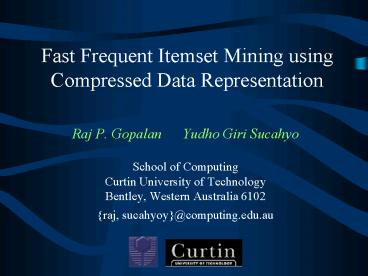Fast Frequent Itemset Mining using Compressed Data Representation - PowerPoint PPT Presentation
1 / 20
Title:
Fast Frequent Itemset Mining using Compressed Data Representation
Description:
Compare the performance with Apriori, Eclat (Zaki 2000), FP-Growth algorithms. Contributions ... Eclat: Vertical representation. Uses tid-intersection in its ... – PowerPoint PPT presentation
Number of Views:241
Avg rating:3.0/5.0
Title: Fast Frequent Itemset Mining using Compressed Data Representation
1
Fast Frequent Itemset Mining using Compressed
Data Representation
- Raj P. Gopalan Yudho Giri Sucahyo
- School of Computing
- Curtin University of Technology
- Bentley, Western Australia 6102
- raj, sucahyoy_at_computing.edu.au
2
Outline
- Introduction
- Data Structure
- Running Examples
- Performance Study
- Comparison with other algorithms
- Further Work
- Conclusion
3
Introduction
- Association rule mining
- Finds interesting patterns or relationships among
items in a given data set. - Two steps
- Find the frequent itemsets.
- Use the result of Step 1 to generate association
rules. - Step 1 computationally very expensive.
- So, focus of significant research effort.
4
Finding Frequent Itemsets
- Two general approaches
- Candidate generation-and-test
- Apriori (Agrawal et al., SIGMOD93) and its
variants - Pattern Growth Approach
- FP-Growth (Han et al., SIGMOD00)
H-Mine (Pei et al., ICDM01) - Data Structures
- Array based H-struct in H-Mine
- Tree based FP-Tree in FP-Growth
5
Contributions
- Propose a new algorithm (named CT-Mine) for
mining complete frequent itemsets directly from
the compressed prefix tree. - Compare the performance with Apriori, Eclat (Zaki
2000), FP-Growth algorithms.
6
Association Rules
- Given a database of transactions containing
various items, statements of the form - A ? B (10, 80)
- 80 of transactions that purchase A also purchase
B and 10 of all transactions contain both of
them.
7
Transaction Tree
8
CT-Mine Data Structure
- ITEMTABLE
- Every item, with its support and a pointer to
the root of the subtree of the item.
- COMPRESSED TRANSACTION TREE
- All transactions of the database containing
frequent items. Only frequent items will be
stored in the tree.
9
CT-Mine Algorithm
- Three steps
- Identify Frequent Items and Initialize ItemTable
- Construct the Compressed Transaction Tree
- Mining
- Algorithm details in paper.
10
Example
11
Example
- 5 (5), 45 (4), 345 (3), 2345 (1), 12345 (0),
12
Performance Study on Connect-4
- Connect-4
- 67,557 trans
- of items 129
- Avg
- 43 items/trans
13
Performance Study on Pumsb
- Pumsb
- 49,046 trans
- of items 2,087
- Avg
- 50 items/trans
14
Performance Study on Chess
- CHESS
- 3,196 trans
- - of items 75
- Avg
- 37 items/trans
15
Comparing with Apriori
- Apriori 4.04
- also uses a prefix tree
- suffers from poor performance since it has to
traverse the database many times to test the
support of candidate itemsets. - CT-Mine
- follows the pattern growth approach
16
Comparing with Eclat
- Eclat
- Vertical representation
- Uses tid-intersection in its mining process.
- There is no compression scheme in Eclat.
17
Comparing with FP-Growth
- FP-Growth uses FP-Tree.
- FP-Tree is used to group transactions.
- No compression scheme to combine identical
subtrees as in CT-Mine. - Number of nodes in CT-Mine will be less by up to
half of the nodes. - CT-Mine does not need to build conditional
FP-Tree.
18
Further Work
- Extend CT-Mine for very large databases.
- Integrate constraints into CT-Mine.
19
Conclusion
- A new algorithm (CT-Mine) for efficient discovery
of frequent itemsets has presented. - A compressed prefix tree is used for efficient
memory usage. - The performance of CT-Mine against Apriori, Eclat
and FP-Growth on various data sets is presented.
The results show that CT-Mine outperformed all
others at most of the common support levels used
in mining.
20
Thank you !!
http//www.cs.curtin.edu.au/sucahyoy































